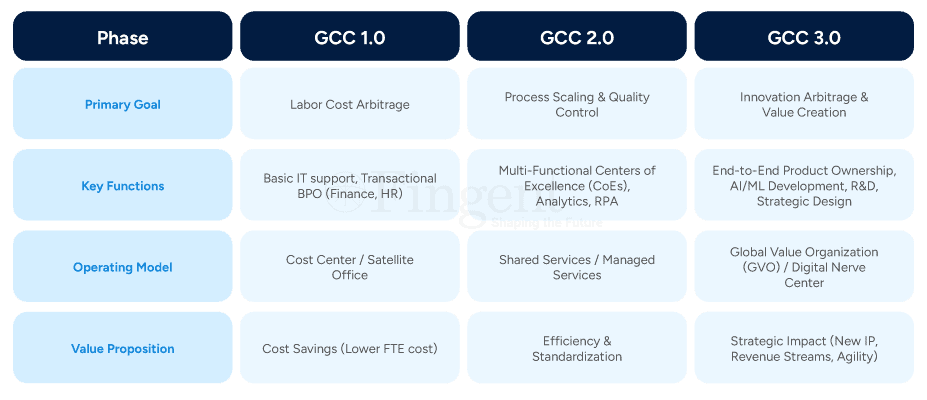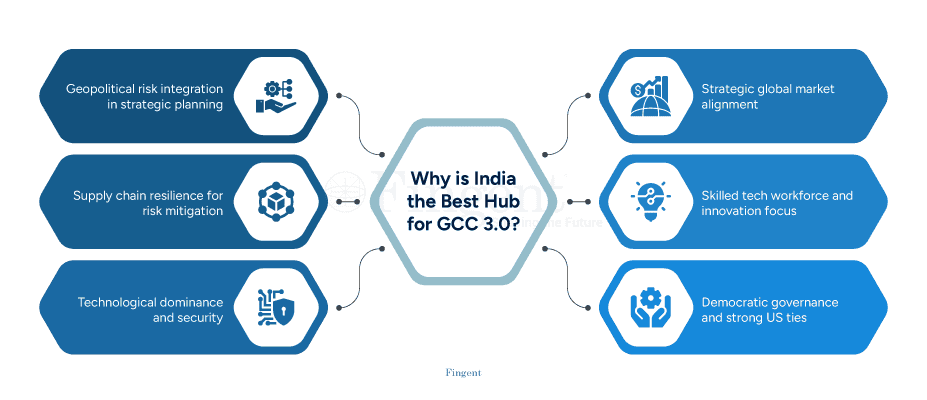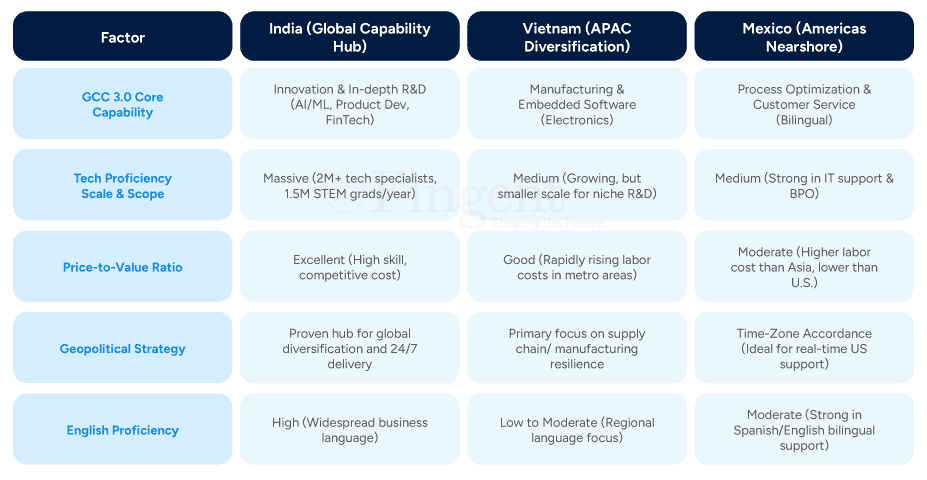Why is GCC 3.0 a Primary Strategic Imperative for US Businesses
US corporations are encountering a sea of challenges currently: frequent geopolitical events that complicate supply chains, unprecedented tech disruptions driven by AI and automation, the intense race for semiconductor dominance, and skyrocketing R&D costs at home. These massive challenges demand a fundamental shift in the way global businesses conduct their operations.
The traditional model of offshoring—often viewed as a means to cut costs—has now given way to Global Capability Centers (GCCs). These global centers no longer serve as simple back offices. Instead, they function as strategic innovation hubs critical to enterprise-wide growth and resilience. For US companies to not only survive but lead in this new era, embracing the GCC 3.0 model is no longer an option—it’s a vital business priority.
What is GCC 3.0, and how does it equip US corporations to sustain and lead the competitive global business landscape? Let’s cut to the chase.
Discover How Fingent’s Global Capability Center Can Accelerate Your Business Growth
The Evolution of GCCs: From Arbitrage to Innovation
The journey of Global Capability Centers is a clear reflection of the changing priorities of multinational corporations (MNCs), especially in the U.S. Understanding this evolution is key to grasping the value of the GCC 3.0 model.

GCC 1.0 was the genesis, focused purely on cost reduction by leveraging lower labor costs in offshore locations. This model was primarily opted for managing standardized, transactional tasks.
GCC 2.0 matured this model by shifting to Centers of Excellence (CoEs). Centers started owning end-to-end processes, focusing on quality, standardization, and scaling core business processes like accounting or IT infrastructure management.
GCC 3.0 is the most recent and critical phase, in which these centers move from execution to co-creation and from delivery to design. GCC 3.0 centers in areas like AI/ML development, cybersecurity, product design, and strategic R&D now act as the digital powerhouses expediting global enterprise transformation, driving the future vision of the parent company.
Why India is the Global Leader of GCC 3.0
While other geographies offer viable options, India has firmly cemented its position as the undisputed global capital for GCC 3.0. India’s ecosystem is uniquely equipped to deliver the high-value functions required for strategic innovation arbitrage.
1. Unmatched Talent Depth and Scale
India hosts nearly 50% of the world’s active GCCs. Every year, the country produces more than 1.5 million graduates in Science, Technology, Engineering, and Mathematics (STEM). It allows Indian GCCs to cultivate a massive pool of professionals skilled in advanced technologies such as Generative AI, Cloud Engineering, Data Science, and Cybersecurity. This distinctive combination of scale and skill is simply not available anywhere else.
2. Strategic Cost-to-Value Proposition
The advantage is no longer just labor cost. GCC 3.0 in India provides a compelling cost-to-value proposition. Businesses in the U.S. can gain access to top-rated engineering teams that can drive global product roadmaps at considerably affordable costs (compared to Silicon Valley). This, eventually, translates into improved productivity and innovation at scale. Partnering with Indian GCCs also helps in addressing the surging R&D expenditures undermining U.S. operations.
3. Full-Fledged IT Ecosystem and Strategic Autonomy
India’s GCC market is driven by a robust and mature infrastructure consisting of thriving startup ecosystems, government aids and tax incentives for the ‘Digital India’ initiative, and strong academic-industry connections such as joint research with Indian Institute of Technologies (IITs). This level of growth and development allows Indian GCCs to take on strategic autonomy, owning end-to-end product mandates, driving independent innovation roadmaps, and co-authoring patents for the parent company.
GCC 3.0 Capability Comparison: India vs. Vietnam vs. Mexico
The choice of location for a GCC must align with a company’s strategic goal, not just proximity or basic cost. For the innovation-driven mandate of GCC 3.0, India stands out against key alternative options like Vietnam (often cited for Southeast Asia diversification) and Mexico (the primary near-shoring option for the Americas).
Tip: For US businesses whose long-term goal is innovation scale and in-depth technology leadership, India’s ecosystem—with its sheer size, specialization in advanced digital skills, and a mature operating model—offers a distinct advantage over the manufacturing-focused talent of Vietnam and the proximity/time-zone benefit of Mexico.
The Key Advantage of Embracing GCC 3.0 for US Companies
By choosing the GCC 3.0 model, U.S. companies gain transformative advantages that promote long-term global competitiveness:
1. Speed-to-Market and Digital Agility
GCC 3.0 centers operate as 24/7 innovation engines. A team in India can pick up development work as the US team signs off, enabling genuine “follow-the-sun” development cycles. This continuous workflow, combined with a skills-first approach known as Talent 3.0, allows for the rapid deployment of capabilities. It significantly increases the speed of digital transformation initiatives (often by 2-3X).
2. A Citadel of Resilience and Compliance
As supply chains turn highly volatile and data regulations become more complex, distributed GCC 3.0 networks contribute to enhancing business resilience. GCC 3.0 teams facilitate effective data governance and risk mitigation across global boundaries by integrating regulatory compliance frameworks and cybersecurity regimes.
3. Innovation as a Service
The transition from cost arbitrage to innovation arbitrage makes GCCs a fresh source of Intellectual Property (IP). Instead of simply executing tasks, GCC 3.0 teams are hired to co-create new products, design innovative digital services, and identify new revenue streams using advanced AI and data analytics. GCCs turn cost centers into innovation engines, which directly impacts the top line of the parent company.
Speed Up Development Cycles. Drive Faster Results. Scale Your Team With Fingent’s Global Capability Center
Conclusion: Taking the Next Step
The challenges nagging US businesses—from geopolitical friction and runaway R&D costs to the pressure of the AI revolution—are too significant to address with a decade-old operating model. Viewing the Global Capability Center as merely an extension for cost savings is a relic of the past.
GCC 3.0, led by India’s strong talent-driven and innovation-focused ecosystem, is the non-negotiable strategic imperative for US corporations.
India’s
GCC 3.0 model provides a scalable, sustainable path to access the world’s deepest pool of advanced technical talent, embed 24/7 agility, and transform core business functions into centers of strategic innovation.
US firms must look beyond mere survival in the global competition landscape and leverage India’s GCC 3.0 capabilities to sustain and lead it. There is no better time than now to pivot from a cost-centric mindset to a value-centric, innovation-driven strategy.
Stay up to date on what's new

Featured Blogs
Stay up to date on
what's new














